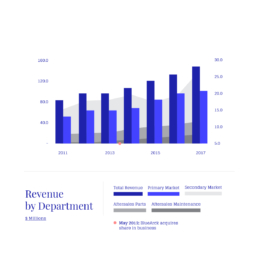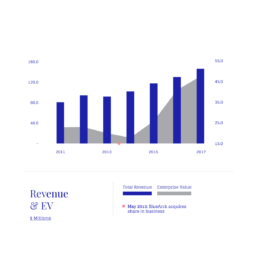Transforming Culture to Inspire Growth
Message from Executive Management
From the outset, we knew the Company had a great reputation with its franchise partners and customers, but very early into our involvement with the company, we found lots of examples of missed opportunities. We risked changing too much, too fast, but had we not taken the steps we did, the downside case suggested a bad outcome. Within 3 years, we had built a durable team of talented professionals and instilled a culture of curiosity that yielded a terrific ROI and gave the team a sense of great accomplishment.Aleem Ahamed, Managing Director, Retail Company A
“Investment was limited to long-term assets, but not into the improvement of human resources”
The Opportunity
In 2013, Caloah became involved with a retail company that had not changed hands since its founding in 1983 and after having been one of the largest groups in British Columbia, had become a stagnant player in an industry that was in the midst of substantive consolidation.
An existing management team was in place that held a significant amount of experience, however, the drive to grow the business had been lost and as a result, systems became outdated and company culture suffered.
Staff had lost passion for the business and viewed their income and career growth as being limited, if not nonexistent, given the lack of company growth and expansion.
The bottom line was driven entirely by cost reduction measures versus pro-growth initiatives.
Decision-making was centralized and management did not have the ability to make simple decisions for fear of retribution. Information distribution and collaboration across business units was non-existent and this lack of transparency further led to a cloud hanging over the management team.
Investment was limited to long-term assets, not into improvement of human resources (through hiring or training) or the necessary technology to operate a modern, growing enterprise.



"Prior systems were cumbersome and led to a lack of information exchange andcollaboration."
The Process
It was identified that one (of four) retail franchises was consuming a disproportionate amount of resources (human and financial) and results did not justify the imbalance. Therefore, the decision to divest the asset was made and excess capital returned to shareholders.
The focus was then to invest in growing the three other divisions and drive value creation through a complete revitalization of company culture.
IT Change Intiative
Prior systems were cumbersome and included slow network speeds, lagging applications and, subsequently, a poor customer experience and frustrated firstline staff.
Each retail location was silo’d and did not communicate effectively to share best practices – this led to a lack of information exchange and collaboration.
Network changes were made to improve workflow and collaboration with a significant investment to bring systems into the 21st century.
Overall, this created a better environment for customers – faster turnaround times and more focus on better conversations internally and externally.
Culture Change Initiative
The goal was to modernize the company by removing the opaque, archaic operating structure and transition the team to a culture of openness and ‘curiosity’.
Instead of decision-making being centralized around one person, an operating structure was created to provide clear expectations and create a hierarchy of empowered leaders.
Transparency was an issue with the prior management style – all information was closely held at the top and the senior leaders did not know how the company was performing. This was immediately changed with unified financial reporting that set clear expectations for performance and created a sense of purpose and intent across the organization.
There was no common mission or core values – these were introduced to unify the team and more clearly identify how ownership was to be reflected through its operations.
The makeup of the management team was restructured to reflect the core values of the company.
Accountability was tied to data-driven metrics with better aligned goals to drive value.
Various levels of financial performance reports were set up and distributed regularly to ensure accountability models were adhered to; wins were widely celebrated and good performance was rewarded.
With a data driven model, it became more clear for management how to best improve operations and identify areas of rapid growth.
Communication with the team was critical, particularly obtaining information from firstline staff – the decentralization of idea generation was critical to generating the strongest results. The best ideas were implemented regardless of origin and if course correction was required, it was done without blame.
Ownership invested in education of its team – one-on-one executive coaching was implemented for senior staff and high potential employees. While training budgets had previously been cut to zero, responsibly deployed executive education programs were instituted.
The concept of ‘servant leadership’ was deployed – the idea being that the more senior the employee, the more aware that person had to be of their role as serving their team.
11.9
41.8
24.2
64
“The change in culture allowed for upward mobility and new opportunities for the team, resulting in a more engaged workforce.”
Results
The results of the above are reflected in the company’s financial performance: Free Cash Flow CAGR 31%, Enterprise Value IRR of 46% (including 50% return of FCF / annum).
The ‘tone at the top’ and culture was re-established to align with the core values of Integrity, Responsibility and Respect. Executives became accountable to the team’s development and the company’s performance.
The change in culture allowed for upward mobility of those team members who were so inclined. Opportunities for new or different career paths within the organization were encouraged and executed upon. This resulted in a more engaged workforce and the attraction of better talent to the organization.
Philanthropic causes were expanded and the number of charitable causes increased from one (Aga Khan Foundation Canada) to four (AKFC, BC Women + Children’s Hospital, Children’s Hearing & Speech of BC, BC Cancer).
In early 2018, Caloah created a successful exit from the business and generated a strong return for shareholders.
